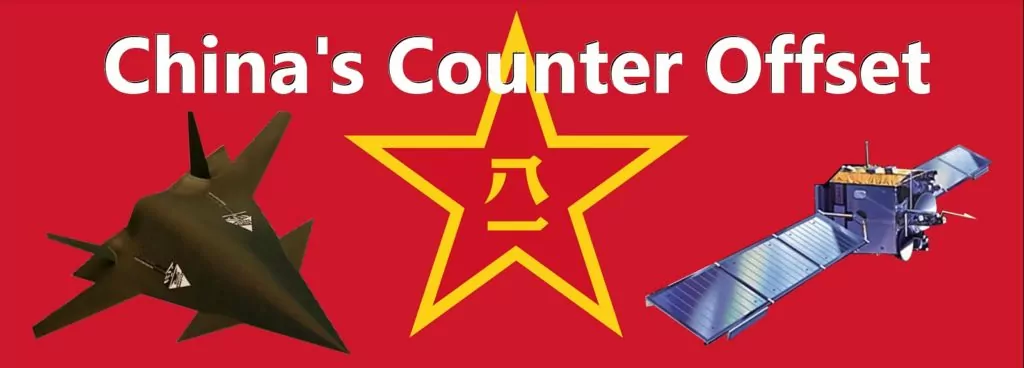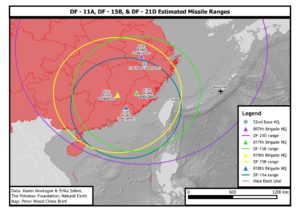China & the Third Offset

“We are not waiting for change to come. We’re not waiting for that change to come to us. We’re taking the initiative, getting ahead of that change – that change we know is coming – and making the long-term investments we need for the future…countries like Russia and China have been heavily investing in military modernization programs to blunt our military’s technological edge, fielding advanced aircraft, submarines, and both longer-range and more accurate missiles. They’re also developing new anti-ship and air-to-air missiles, counter-space, cyber, electronic warfare, undersea, and air attack capabilities. America must continue to ensure its ability to project power rapidly across oceans and continents by surging aircraft, ships troops and supplies. If this capability is eroded or lost, we will see a world far more dangerous and unstable, far more threatening to America and our citizens here at home than we have seen since World War II.”
Chuck Hagel, 2014
“China and Russia now have theater-wide battle networks that are approaching parity with us, so to strengthen conventional deterrence, we want to make sure that we can extend our advantage in that area.”
Deputy Defense Secretary Robert Work (link)
The United States has embarked on a military modernization program known as the “Third Offset”, meant to provide U.S. forces with capabilities far in advance of its potential adversaries. Creating such a capability involves research into cutting edge technologies such as artificial intelligence, hypersonic weapons, lasers, and advanced computing. Since the policy was announced in 2014, however, China and Russia have taken note and embarked on their own focused research programs to respond to U.S. technical advances. We have collected a series of our articles regarding Chinese responses to the Third Offset, and will continue to publish more analysis on this topic throughout the year.
Chinese Perceptions of the “Third Offset Strategy”
By: Peter Wood
Volume 16 Issue 15 October 4, 2016
China is deeply committed to a series of military reforms involving reorganization, more realistic training, and advanced weapons—all interconnected by information technology and with the various services and branches working jointly. It set itself two milestones—2020 and 2049. The first of these is to complete military mechanization and full informatization. However, this goal is predicated on achieving a level of technology to deal with the threat posed by high-tech, precision warfare demonstrated by the United States during the first Gulf War in 1991. However, since 2014, U.S. Defense policy-makers, beginning with then-Secretary of Defense Chuck Hagel have committed to pushing the United States military advantages to the next level to respond to emerging conventional military power parity, the “Third Offset” . Chinese academics and military practitioners are closely watching the “Third Offset” and considering how to recalibrate China’s own modernization plans in response.
Swarms at War: Chinese Advances in Swarm Intelligence
By: Elsa Kania
Volume 17 Issue 9 July 7, 2017
The Chinese People’s Liberation Army (PLA) anticipates that future warfare will be “unmanned, invisible, and silent” (“无人、无形、无声”战争), with ever higher degrees of “intelligentization” (智能化). [1] PLA strategists expect that future, autonomous combat involving unmanned systems, as well as the joint operations of unmanned and manned systems, will have a dramatic impact on traditional operational models. Future UAV swarming (无人机集群) will involve “intelligentized” and semi- or fully autonomous systems. The PLA recognizes the disruptive potential of these techniques, which could be used for saturation assaults (饱和攻击) to overwhelm the defenses of high-value targets, including perhaps U.S. fighter jets or aircraft carriers. Chinese advances in artificial intelligence, including deep learning techniques, have enabled considerable progress in swarm intelligence. There is technical and conceptual research, development, and testing ongoing across Chinese academic institutions, the private sector, defense industry, and military research institutes to support such capabilities. At this point, given the limited information available and the relative opacity of these efforts, it is difficult to compare U.S. and Chinese advances in swarm intelligence. Nonetheless, the PLA has closely tracked U.S. initiatives focused on swarm tactics and seeks to develop countermeasures and comparable capabilities. Looking forward, the PLA’s advances in intelligent unmanned systems and swarm tactics could serve as a force multiplier for its future military capabilities.
Chinese Hypersonic Weapons Development
By: Erika Solem, Karen Montague
Volume: 16 Issue: 7 April 21, 2016

China’s military is reorganizing itself to be a more modern, effective force. On January 1, 2016, the Second Artillery Force (第二炮兵部队) (responsible for China’s nuclear and conventional arsenals) was reorganized into the People’s Liberation Army Rocket Force (PLARF; 火箭部队), elevating it to a service (军种) fully on-par with the Navy, Army, and Air Force. As China streamlines its military and works to improve the quality of its personnel, several cutting edge projects are in the works to provide the People’s Liberation Army with advanced weapons. One of these is the PRC’s hypersonic glide vehicle (HGV), called the DF-ZF in China and previously designated by U.S. defense officials as the Wu-14. The development and testing of this new class of hypersonic weaponry in China has been extremely secretive. However, its eventual implementation will represent a significant improvement in the PLARF’s conventional and nuclear arsenals, as it has the potential to penetrate even the strongest layered anti-missile defenses of the United States and its allies.
Quantum Leap (Part 1): China’s Advances in Quantum Information Science

By: Elsa Kania, John Costello
Volume: 16 Issue: 19 December 21, 2016
In August 2016, the launch of the world’s first quantum satellite, Micius (墨子), drew international attention China’s rapid advances in quantum information science. These breakthroughs demonstrate the success of a long-term national research agenda that prioritized innovation in this critical technological domain. Under the leadership of Xi Jinping, this high-level focus on quantum information science has intensified and been explicitly linked to both national security and economic competition. While it is difficult to evaluate the feasibility or timeframe within which China’s quantum ambitions may be realized, Chinese scientists’ consistent progress in quantum information science seems likely to continue. Looking forward, China could potentially leapfrog the U.S. in this critical technological domain to become the world’s first quantum power.
Quantum Leap (Part 2): The Strategic Implications of Quantum Technologies
By: Elsa Kania, John Costello
Volume: 16 Issue: 18 December 5, 2016
China’s high-level focus on quantum information science reflects its recognition of the revolutionary implications of quantum technologies. China has operationalized and employed “unhackable” quantum cryptography to secure sensitive communications, while pursuing quantum computing capabilities whose enormous computing power could overcome most existing forms of encryption. Concurrently, Chinese scientists are starting to explore other quantum technologies, including supposedly “stealth-defeating” quantum radar. The Chinese People’s Liberation Army (PLA) recognizes the strategic significance and operational potential of quantum technologies in their attempts to achieve a decisive advantage. Notably, these disruptive technologies—quantum communications, quantum computing, and potentially quantum radar—may have the potential to undermine cornerstones of U.S. technological dominance in information-age warfare, its sophisticated intelligence apparatus, satellites and secure communications networks, and stealth technologies.
Disruption Under the Radar: Chinese Advances in Quantum Sensing
By: Elsa Kania, Stephen Armitage
Volume: 17 Issue: 11 August 17, 2017
Technologies that harness the “spooky” properties of quantum phenomena, once purely science fiction, are fast becoming a reality. Backed by the Chinese leadership at the highest levels, Chinese scientists are achieving rapid progress in a variety of different applications, including quantum encryption—which creates uncrackable communication—and quantum computing, which will enable tremendous computing power that could render most modern forms of encryption obsolete. While each of these technologies could rewrite the rules of how information can be used and processed, quantum sensing—the use of quantum entanglement to enable extremely precise measurement—could most fundamentally alter operational realities of future conflict. Quantum sensing technologies such as quantum radar can be used to detect targets that cannot be discerned through conventional radar, and quantum navigation leverages quantum properties to create a precise form of positioning system that may eventually replace GPS. Together, such technologies could be critical to China’s future military capabilities and might become a key focus of U.S.-China technological competition.Together, such technologies could be critical to China’s future military capabilities and might become a key focus of U.S.-China technological competition.
China’s Secure Communications Quantum Leap
By: Matthew Luce
Volume: 10 Issue: 17 August 19, 2010
In May 2010 a team of 15 Chinese researchers from Tsinghua University in Beijing and the Hefei National Laboratory for Physical Sciences, a government-directed research center, published a research paper announcing a successful demonstration of “quantum teleportation” (liangzi yinxing chuan) over 16 kilometers of free space. These researchers claimed to have the first successful experiment in the world. The technology on display has the potential to revolutionize secure communications for military and intelligence organizations and may become the watershed of a research race in communication and information technology.